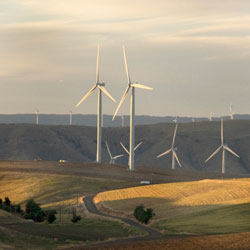 The wind industry sees climate change as an opportunity. In a world where reducing carbon will most likely be the norm, wind power is seen as valuable, in part, due to its lack of greenhouse gas emissions.
The wind industry sees climate change as an opportunity. In a world where reducing carbon will most likely be the norm, wind power is seen as valuable, in part, due to its lack of greenhouse gas emissions.
However, climate change also presents risks and threats to wind energy in terms of wind resources. Is there a chance that wind could also become a casualty of climate change?
According to various scientists, the major risks for wind power fall into two basic categories – changes in the wind resource distribution and risks to infrastructure. All forms of renewable energy are somewhat sensitive to climate variation. While not as vulnerable to climate change as hydropower or biomass, wind resources will likely face some shifts in location, intensity, interval and duration.
However, those shifts are difficult to predict. While climate models do include air-circulation patterns, the models' outputs focus primarily on projected changes in temperature and precipitation, not wind flows.
‘There is a long way to go in this research,’ says Melinda Marquis, a scientist at the National Oceanic and Atmospheric Administration. ‘Climate models could certainly be tailored and tweaked to better predict changes in wind. Wind research in general is just starting to ask these questions.’
Wind researchers often ask whether climate change will increase or decrease wind speeds. Recent studies give conflicting answers. Last fall, a University of Texas-Austin researcher estimated that global temperature increases of 2 degrees C to 4 degrees C could result in a 4% to 12% decrease in average wind speeds in some northern latitudes. A 2009 Iowa State University study found that average wind speeds across the country have already decreased .5% to 1% since 1973.
However, researchers at the University of California-Santa Cruz found that climate change might cause coastal winds to increase.
‘Don't make too many assumptions," warns Johannes Feddema, a University of Kansas professor and scientist at the United Nations' Intergovernmental Panel on Climate Change (IPCC). ‘The impact of climate change on wind speeds is very complicated.’
As Feddema explains, part of the complexity has to do with the definition of wind – whether scientists are talking about global air-circulation patterns in the upper atmosphere or local winds in the lower atmosphere.
In general, wind is the movement of air masses. For global air-circulation patterns, the main drivers are differing temperature gradients between the earth's equator and poles. In turn, these mammoth upper atmosphere currents provide – or dampen – energy for local wind patterns and weather.
However, as Feddema points out, global warming is already heating up pole temperatures (especially the Arctic) at a much faster rate than at the equator. The prevailing wisdom is that as the temperature gradient between the pole and the equator lessens, global air circulation will slow as well, especially in northern latitudes.
Local winds could also slow down, according to Feddema. However, in other areas, winds may actually increase, thanks to local temperature gradients becoming more influential than global ones. To add to the complexity, temperature gradients are not the only factors driving wind speeds. There are many other variables, including topography, land use, bodies of water, air moisture and land temperature. There are also many seasonal and daily variables.
Both Feddema and Marquis point out that climate change could alter the jet stream, completely rearranging global air circulation and ocean currents, therefore changing many local wind patterns. Marquis adds that there are also "interesting possibilities" of shifts in atmospheric circulation patterns such as El Nino/ La Nina Southern Oscillation.
A 2008 report from the U.S. Climate Change Science Program (USCCSP) noted that wind power could see either "significant positive or negative effects" as a result of climate change.
The time frame for these changes is unknown. As Feddema observes, though, climate change appears to be proceeding faster than the original IPCC projections.
As noted in the USCCSP report, the entire energy sector is vulnerable to climate change. Extreme weather and storms damage the grid, hurricanes threaten offshore installations, and higher temperatures overheat equipment and pipelines. Many key infrastructures are located along coastlines or river valleys, where flooding and rising sea levels could become a factor.
The wind industry will also likely face difficulty with site selection and wind forecasting. For site selection, measurements of past wind speeds might not accurately predict future wind speeds under a scenario of rapid versus gradual climate change.
In an environment where local wind and weather patterns become more extreme and unpredictable, wind forecasting could also become more difficult.
‘An increase in extreme weather means an increase in damaging high winds useless to the wind industry,’ says Feddema. Likewise, a general slowdown in global circulation could also mean more slow days with less wind energy.
Climate change could have indirect effects on wind power (and the entire power sector) as well. For example, changes in water availability, growing seasons, crops, human health and air quality could eventually spur long-term population shifts. Such shifts might cause land-use changes that would in turn affect local wind patterns or force a redistribution of energy infrastructure.
When it comes to climate change, wind holds a significant advantage over other forms of power. Unlike natural gas, nuclear or coal, wind power does not compete for increasingly scarce water resources.
The wind industry also has strengths that will help it in climate-change adaptation. Turbine efficiency will result in turbines that can produce more power with less wind. In addition, storage technologies such as pumped hydro, compressed air energy storage, batteries and electric vehicles will become increasingly viable in the future.
Maril Hazlett is a freelance writer living in Kansas.



